TOYOTA HILUX 2013 Owners Manual (in English)
Manufacturer: TOYOTA, Model Year: 2013, Model line: HILUX, Model: TOYOTA HILUX 2013Pages: 644, PDF Size: 34.35 MB
Page 211 of 644
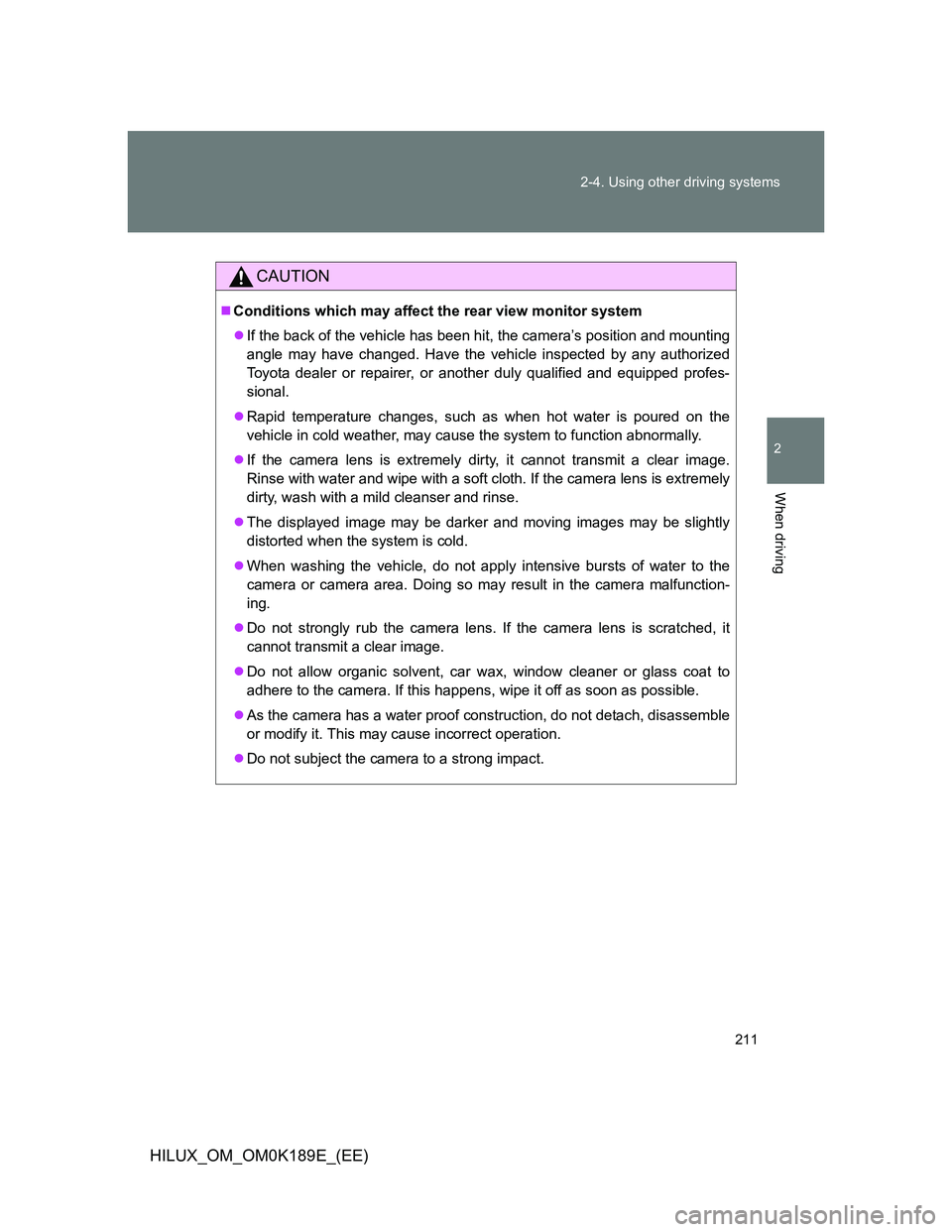
211 2-4. Using other driving systems
2
When driving
HILUX_OM_OM0K189E_(EE)
CAUTION
Conditions which may affect the rear view monitor system
If the back of the vehicle has been hit, the camera’s position and mounting
angle may have changed. Have the vehicle inspected by any authorized
Toyota dealer or repairer, or another duly qualified and equipped profes-
sional.
Rapid temperature changes, such as when hot water is poured on the
vehicle in cold weather, may cause the system to function abnormally.
If the camera lens is extremely dirty, it cannot transmit a clear image.
Rinse with water and wipe with a soft cloth. If the camera lens is extremely
dirty, wash with a mild cleanser and rinse.
The displayed image may be darker and moving images may be slightly
distorted when the system is cold.
When washing the vehicle, do not apply intensive bursts of water to the
camera or camera area. Doing so may result in the camera malfunction-
ing.
Do not strongly rub the camera lens. If the camera lens is scratched, it
cannot transmit a clear image.
Do not allow organic solvent, car wax, window cleaner or glass coat to
adhere to the camera. If this happens, wipe it off as soon as possible.
As the camera has a water proof construction, do not detach, disassemble
or modify it. This may cause incorrect operation.
Do not subject the camera to a strong impact.
Page 212 of 644

212
2-4. Using other driving systems
HILUX_OM_OM0K189E_(EE)
Four-wheel drive system
: If equipped
Use the front drive control lever to select the following transfer
modes.
H2 (high speed position, two-wheel drive)
Use this for normal driving on dry hard-surfaced roads. This position
gives greater economy, quietest ride and least wear.
H4 (high speed position, four-wheel drive)
Use this for driving only on tracks that permit the tires slide, like off-
road, icy or snow-covered roads. This position provides greater traction
than two-wheel drive.
The four-wheel drive indicator light comes on
Page 213 of 644
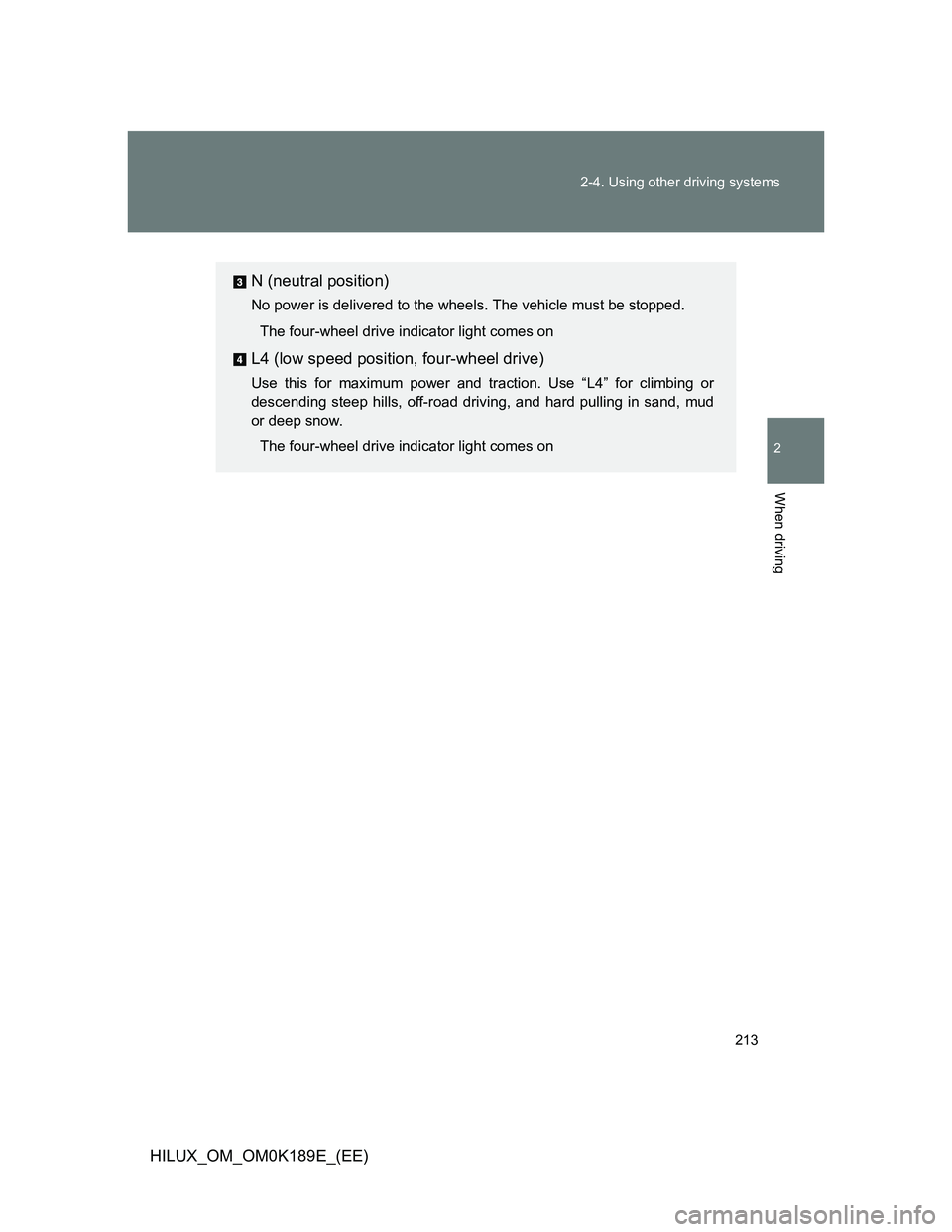
213 2-4. Using other driving systems
2
When driving
HILUX_OM_OM0K189E_(EE)
N (neutral position)
No power is delivered to the wheels. The vehicle must be stopped.
The four-wheel drive indicator light comes on
L4 (low speed position, four-wheel drive)
Use this for maximum power and traction. Use “L4” for climbing or
descending steep hills, off-road driving, and hard pulling in sand, mud
or deep snow.
The four-wheel drive indicator light comes on
Page 214 of 644
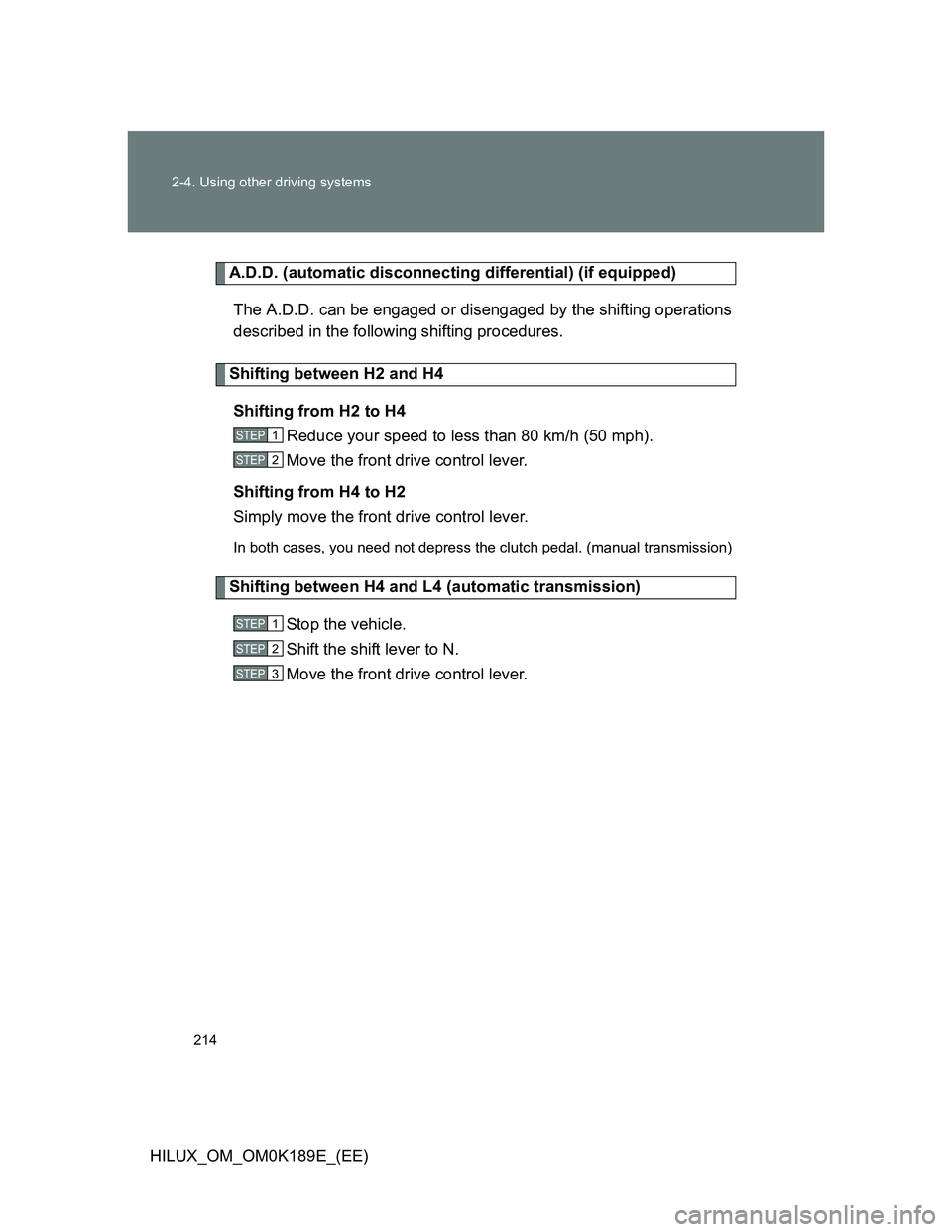
214 2-4. Using other driving systems
HILUX_OM_OM0K189E_(EE)
A.D.D. (automatic disconnecting differential) (if equipped)
The A.D.D. can be engaged or disengaged by the shifting operations
described in the following shifting procedures.
Shifting between H2 and H4
Shifting from H2 to H4
Reduce your speed to less than 80 km/h (50 mph).
Move the front drive control lever.
Shifting from H4 to H2
Simply move the front drive control lever.
In both cases, you need not depress the clutch pedal. (manual transmission)
Shifting between H4 and L4 (automatic transmission)
Stop the vehicle.
Shift the shift lever to N.
Move the front drive control lever.
STEP1
STEP2
STEP1
STEP2
STEP3
Page 215 of 644
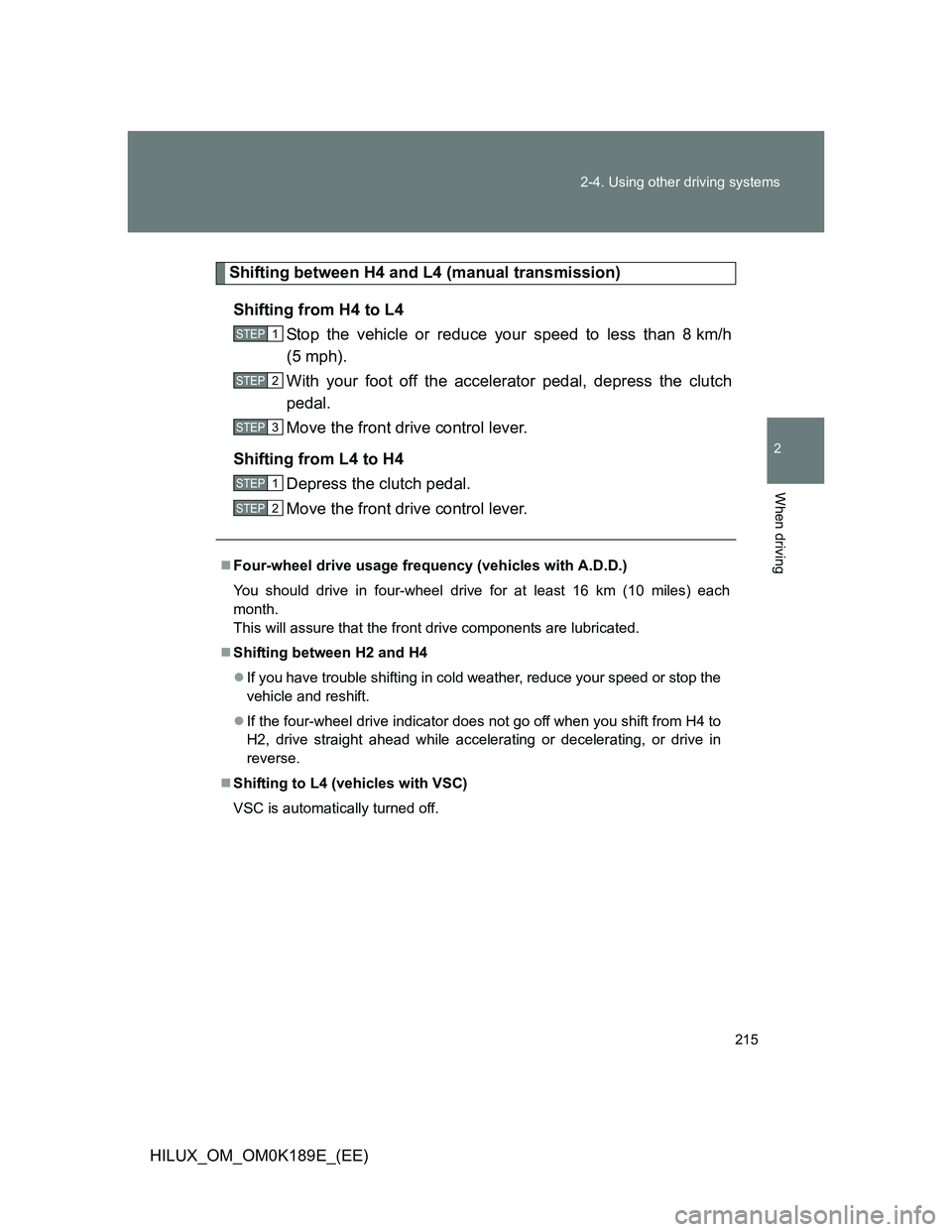
215 2-4. Using other driving systems
2
When driving
HILUX_OM_OM0K189E_(EE)
Shifting between H4 and L4 (manual transmission)
Shifting from H4 to L4
Stop the vehicle or reduce your speed to less than 8 km/h
(5 mph).
With your foot off the accelerator pedal, depress the clutch
pedal.
Move the front drive control lever.
Shifting from L4 to H4
Depress the clutch pedal.
Move the front drive control lever.
Four-wheel drive usage frequency (vehicles with A.D.D.)
You should drive in four-wheel drive for at least 16 km (10 miles) each
month.
This will assure that the front drive components are lubricated.
Shifting between H2 and H4
If you have trouble shifting in cold weather, reduce your speed or stop the
vehicle and reshift.
If the four-wheel drive indicator does not go off when you shift from H4 to
H2, drive straight ahead while accelerating or decelerating, or drive in
reverse.
Shifting to L4 (vehicles with VSC)
VSC is automatically turned off.
STEP1
STEP2
STEP3
STEP1
STEP2
Page 216 of 644
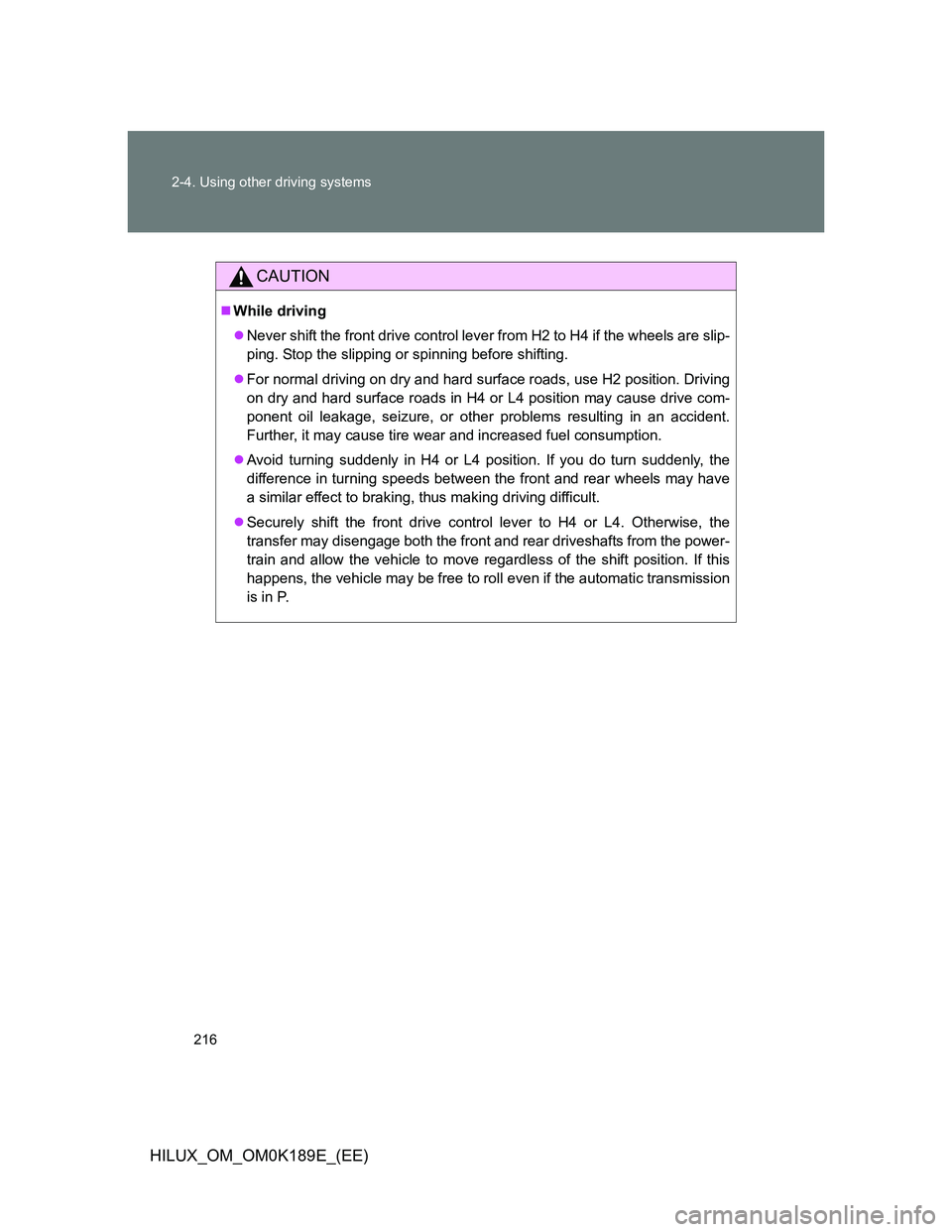
216 2-4. Using other driving systems
HILUX_OM_OM0K189E_(EE)
CAUTION
While driving
Never shift the front drive control lever from H2 to H4 if the wheels are slip-
ping. Stop the slipping or spinning before shifting.
For normal driving on dry and hard surface roads, use H2 position. Driving
on dry and hard surface roads in H4 or L4 position may cause drive com-
ponent oil leakage, seizure, or other problems resulting in an accident.
Further, it may cause tire wear and increased fuel consumption.
Avoid turning suddenly in H4 or L4 position. If you do turn suddenly, the
difference in turning speeds between the front and rear wheels may have
a similar effect to braking, thus making driving difficult.
Securely shift the front drive control lever to H4 or L4. Otherwise, the
transfer may disengage both the front and rear driveshafts from the power-
train and allow the vehicle to move regardless of the shift position. If this
happens, the vehicle may be free to roll even if the automatic transmission
is in P.
Page 217 of 644
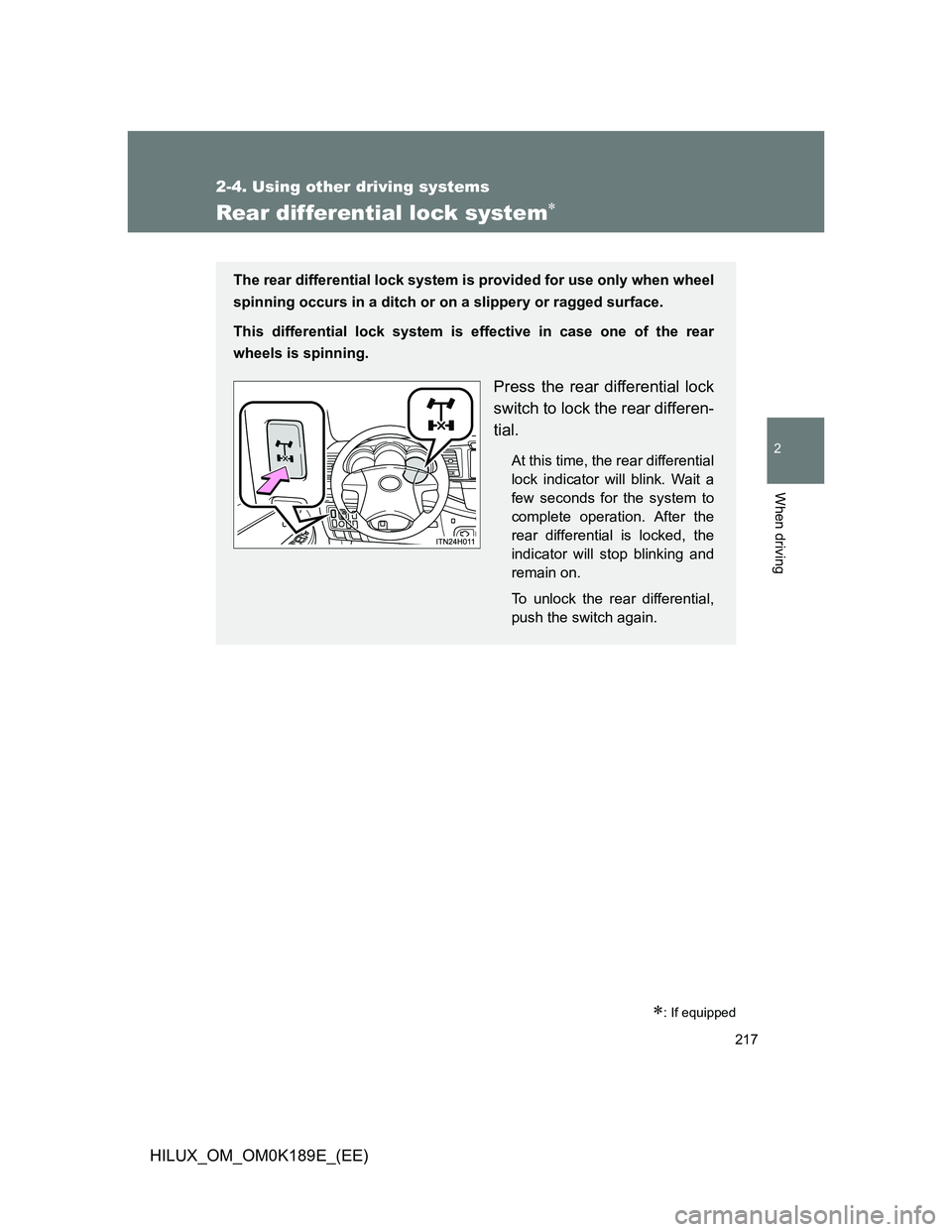
217
2-4. Using other driving systems
2
When driving
HILUX_OM_OM0K189E_(EE)
Rear differential lock system
: If equipped
The rear differential lock system is provided for use only when wheel
spinning occurs in a ditch or on a slippery or ragged surface.
This differential lock system is effective in case one of the rear
wheels is spinning.
Press the rear differential lock
switch to lock the rear differen-
tial.
At this time, the rear differential
lock indicator will blink. Wait a
few seconds for the system to
complete operation. After the
rear differential is locked, the
indicator will stop blinking and
remain on.
To unlock the rear differential,
push the switch again.
Page 218 of 644
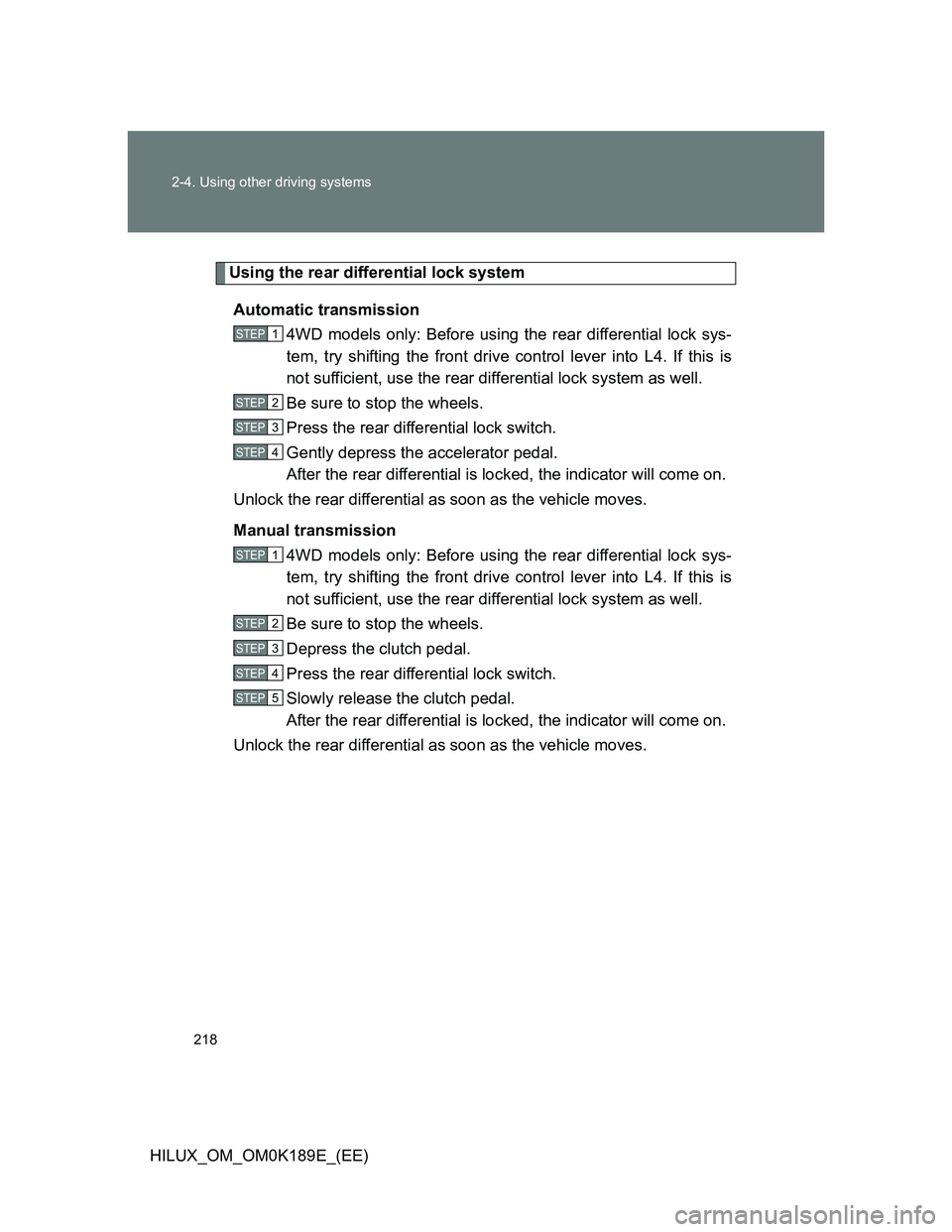
218 2-4. Using other driving systems
HILUX_OM_OM0K189E_(EE)
Using the rear differential lock system
Automatic transmission
4WD models only: Before using the rear differential lock sys-
tem, try shifting the front drive control lever into L4. If this is
not sufficient, use the rear differential lock system as well.
Be sure to stop the wheels.
Press the rear differential lock switch.
Gently depress the accelerator pedal.
After the rear differential is locked, the indicator will come on.
Unlock the rear differential as soon as the vehicle moves.
Manual transmission
4WD models only: Before using the rear differential lock sys-
tem, try shifting the front drive control lever into L4. If this is
not sufficient, use the rear differential lock system as well.
Be sure to stop the wheels.
Depress the clutch pedal.
Press the rear differential lock switch.
Slowly release the clutch pedal.
After the rear differential is locked, the indicator will come on.
Unlock the rear differential as soon as the vehicle moves.
STEP1
STEP2
STEP3
STEP4
STEP1
STEP2
STEP3
STEP4
STEP5
Page 219 of 644
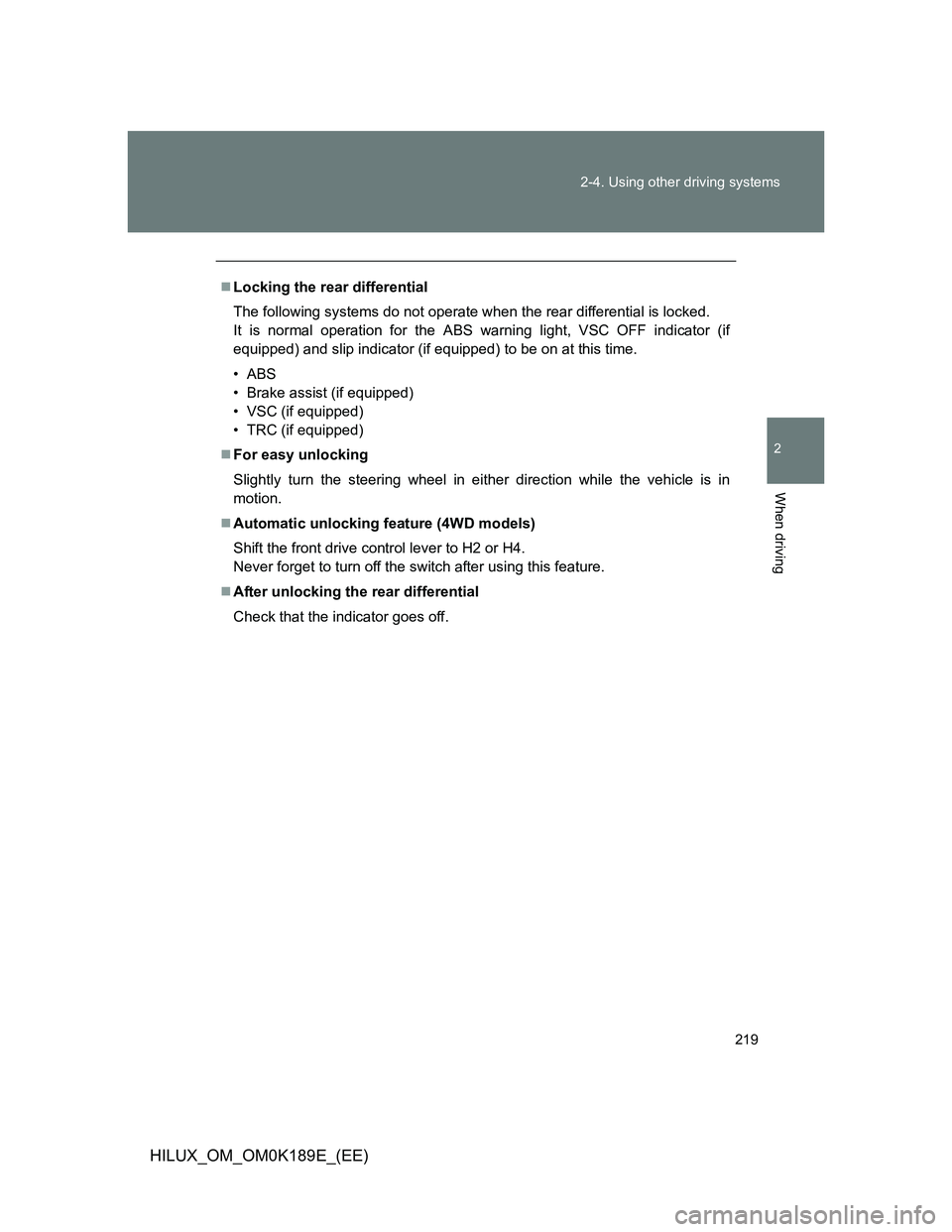
219 2-4. Using other driving systems
2
When driving
HILUX_OM_OM0K189E_(EE)
Locking the rear differential
The following systems do not operate when the rear differential is locked.
It is normal operation for the ABS warning light, VSC OFF indicator (if
equipped) and slip indicator (if equipped) to be on at this time.
•ABS
• Brake assist (if equipped)
• VSC (if equipped)
• TRC (if equipped)
For easy unlocking
Slightly turn the steering wheel in either direction while the vehicle is in
motion.
Automatic unlocking feature (4WD models)
Shift the front drive control lever to H2 or H4.
Never forget to turn off the switch after using this feature.
After unlocking the rear differential
Check that the indicator goes off.
Page 220 of 644
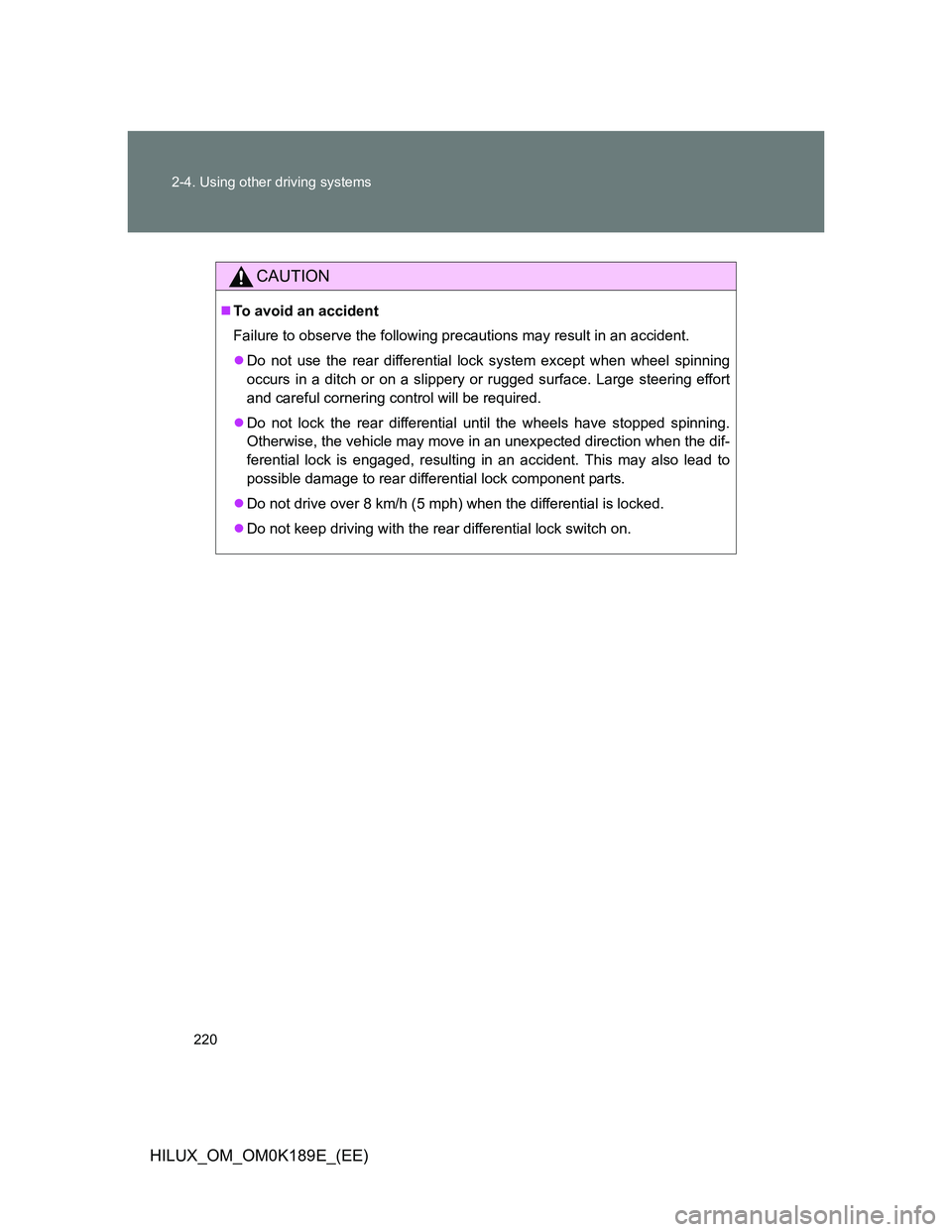
220 2-4. Using other driving systems
HILUX_OM_OM0K189E_(EE)
CAUTION
To avoid an accident
Failure to observe the following precautions may result in an accident.
Do not use the rear differential lock system except when wheel spinning
occurs in a ditch or on a slippery or rugged surface. Large steering effort
and careful cornering control will be required.
Do not lock the rear differential until the wheels have stopped spinning.
Otherwise, the vehicle may move in an unexpected direction when the dif-
ferential lock is engaged, resulting in an accident. This may also lead to
possible damage to rear differential lock component parts.
Do not drive over 8 km/h (5 mph) when the differential is locked.
Do not keep driving with the rear differential lock switch on.